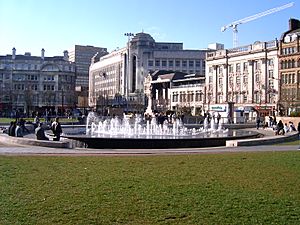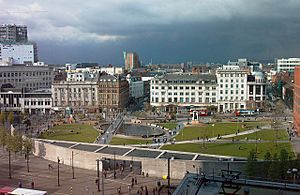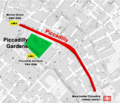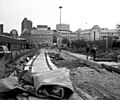Piccadilly Gardens facts for kids
Piccadilly Gardens is a popular green space in Manchester city centre, England. It sits between busy Market Street and the edge of the Northern Quarter. The area was updated in 2002. It now features a cool water feature and a concrete building designed by a famous Japanese architect named Tadao Ando.
Contents
A Look Back: History of Piccadilly Gardens
Piccadilly Gardens has a long and interesting history.
From Clay Pits to a Park
- Before 1755, this area was just a bunch of water-filled clay pits. People called them the "Daub Holes."
- In 1755, the local leader gave the land away. The pits were filled, and a nice ornamental pond was created.
- Later that year, the Manchester Royal Infirmary hospital was built here. The street it was on became known as Piccadilly.
- In 1763, a special hospital for mental health, the Manchester Royal Lunatic Asylum, was built next to the main hospital.
Hospitals Move, Green Space Appears
- By 1849, the mental health hospital moved to Cheadle. It is now called Cheadle Royal Hospital.
- The main Manchester Royal Infirmary moved to a new location on Oxford Road in 1908.
- By 1910, the old hospital buildings were completely taken down. Only a small part for minor injuries stayed open for a while.
- For several years, city leaders tried to decide what to do with the empty land.
- Finally, in 1914, it was decided to turn the area into the biggest open green space in the city centre. A part of the old hospital's basement became a sunken garden.
Modern Makeover: 2000s Changes
- Between 2001 and 2003, Piccadilly Gardens got a big makeover. A new office building, One Piccadilly Gardens, was also built.
- For many years, Piccadilly Gardens has been the main place for public transport in Manchester.
- It is only a five-minute walk from Manchester Piccadilly railway station. It is also about a 10-minute walk from Manchester Victoria railway station.
Designing the New Gardens
- The city council held a contest to redesign Piccadilly Gardens.
- In 1998, the winners were announced. They included EDAW, a landscape design company, and their partners.
- These partners were the engineers Arup, the famous Japanese architect Tadao Ando, and local architects Chapman Robinson.
- The square was finally updated in 2001–2002. It got new green areas and fountains designed by EDAW.
- Tadao Ando designed a special building, called a pavilion. This building helps shield the gardens from the busy transport area.
- At the same time, the One Piccadilly Gardens office building was built.
- The new design was very different from the old gardens. Only the original statues remained.
- This redesign was part of a huge building project in Manchester. The city was getting ready to host the 2002 Commonwealth Games.
- Before the makeover, the square was looking old and felt unsafe.
- The renovation cost about £10 million. In 2003, it was even nominated for a special award for public buildings.
Criticism of the New Design
- However, the new design soon received some criticism. Some people thought it looked "cold" and too "modern."
- The concrete wall designed by Tadao Ando was even nicknamed the "Berlin Wall" by locals.
- Part of this wall was removed in November 2020 as part of new plans.
- The grass in the gardens often turns to mud because so many people use it. It has to be replaced regularly.
- The fountains are popular with kids in summer. But sometimes, broken glass can be a problem there.
- The One Piccadilly Gardens building also caused some debate. People were concerned about selling public land. Also, the building is very tall and blocks sunlight from the gardens.
Getting Around: Transport at Piccadilly Gardens
Piccadilly Gardens is a major place where you can catch buses and trams. It is a very important public transport interchange.
- There are two Metrolink tram stops very close by.
- The Piccadilly Gardens stop is south of the green area. Trams from here go to and from Piccadilly station.
- The Market Street stop is on Market Street to the north. Trams from here go to and from Victoria station.
- Right next to the Piccadilly Gardens tram stop, there is also a bus station, called Manchester Piccadilly Gardens bus station. Many more bus stops are on the nearby streets.
- You can get information about Manchester's transport system at the Transport for Greater Manchester "Travelshop." It is located next to the bus station and tram stop.
Around the Square: Buildings and Statues
The buildings around Piccadilly Gardens show Manchester's history. You can see old Victorian warehouses from the Industrial Revolution. These buildings remind us of Manchester's past as a cotton trading city. There are also new office buildings from the 21st century.
- The huge Piccadilly Plaza complex is one of the first buildings visitors notice.
- One Piccadilly Gardens, built in 2003, is on the east side of the square. It has offices on six floors and shops and restaurants on the ground floor.
Piccadilly Plaza Complex
- Piccadilly Plaza was first built between 1959 and 1965. It was updated in 2001.
- It includes the renovated Mercure Hotel.
- The very tall building, once called Sunley Tower, is now known as City Tower.
- In 2005, the Plaza had a big makeover. The tower was re-covered, and the concrete walls were cleaned.
- Now, there are several shops and large office spaces available in the complex.
Historic Hotels
- The Thistle Hotel stands on the south-eastern side of Piccadilly Gardens. It used to be three cotton warehouses.
- The Britannia Hotel on Portland Street is also a very old building. It was once the largest warehouse in Manchester, called Watts Warehouse.
Wheel of Manchester
From 2013 to 2015, a giant Ferris wheel called the Wheel of Manchester was located in the square.
Important Old Buildings and Statues
Many important old buildings, called "listed buildings," stand around Piccadilly Gardens. These buildings are protected because they are historically or architecturally special.
There are also several statues in Piccadilly Gardens:
- The statue of Sir Robert Peel. He was a very important British Prime Minister.
- The statue of James Watt. He was a Scottish inventor and engineer who made big improvements to the steam engine.
- Edward Onslow Ford's Queen Victoria Monument. She was the Queen of the United Kingdom for a very long time.
- The statue of the Duke of Wellington. He was a famous general who defeated Napoleon.
These four statues were placed here at different times. The first was Sir Robert Peel's statue in 1853. Queen Victoria's statue was added after she passed away.
Images for kids
-
Sir Robert Peel (1850)
-
James Watt (1857)
-
Duke of Wellington (1853)
-
Queen Victoria (1901)
















